WordPress'te medya dosyalarını yönetmek, siteniz büyüdükçe bunaltıcı olabilir. Dağınık bir medya kütüphanesi sitenizi yavaşlatabilir ve basit güncellemeleri zaman alıcı hale getirebilir.
Birçok WordPress kullanıcısının web sitelerini temizlemelerine yardımcı olduk ve medya yükleme konumunuzu değiştirmenin sadece düzenlilikten daha fazlası olduğunu biliyoruz.
Daha iyi dosya organizasyonunun yanı sıra, bu değişiklik web sitenizi hızlandırabilir, yedeklemeleri basitleştirebilir, güvenliği artırabilir ve hatta içerik teslimini iyileştirebilir.
Bu kılavuzda, WordPress medya yükleme konumlarını değiştirmenin etkili yöntemini göstereceğiz. İster küçük bir blogunuz ister çok sayıda medya dosyasına sahip bir iş siteniz olsun, bunu doğru şekilde nasıl kuracağınızı öğreneceksiniz.
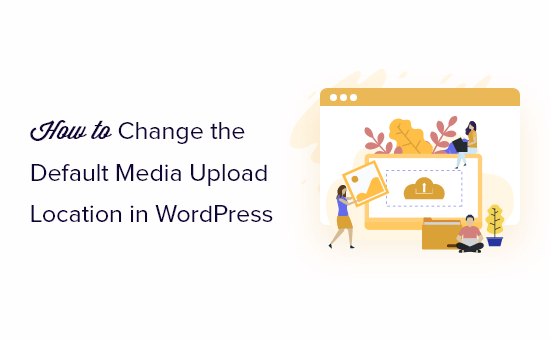
Varsayılan Medya Yükleme Konumunu Neden Değiştirmeli?
Resimleri, videoları veya diğer dosyaları WordPress web sitenize yüklediğinizde, bunlar sunucunuzdaki belirli bir klasörde saklanır.
Varsayılan olarak WordPress, tüm medya yüklemelerini web sitenizin dosya yöneticisinde veya bir FTP istemcisi aracılığıyla bulabileceğiniz /wp-content/uploads/ dizininde saklar.
Bu klasörün içinde, farklı yıllar ve aylar için alt klasörler bulacaksınız. Örneğin, Ocak 2024'te yüklediğiniz tüm dosyalar https://example.com/wp-content/uploads/2024/01/ konumunda saklanacaktır.
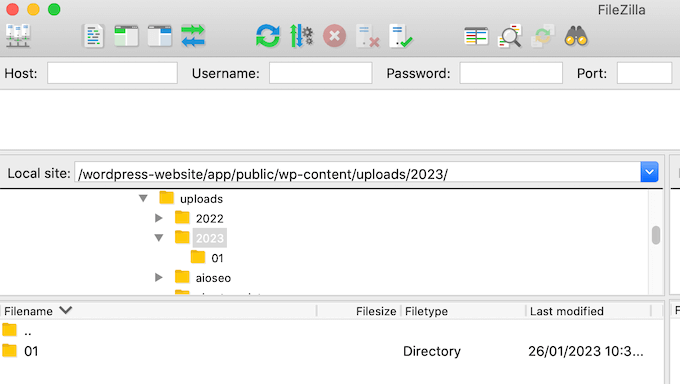
Bu varsayılan yapı, çoğu WordPress blogu ve web sitesi için iyi çalışır. Ancak, bazen WordPress'in dosyalarınızı nereye kaydettiğini değiştirmek isteyebilirsiniz.
Örneğin, resimleri bir alt alan adında barındırabilirsiniz, çünkü bu, WordPress performansınızı hızlandırabilir.
Bir CDN kullanıyorsanız, yükleme konumunu CDN'nin depolamasına işaret edecek şekilde değiştirmek isteyebilirsiniz. Bu, medya dosyalarınızı küresel olarak dağıtmaya yardımcı olabilir ve farklı coğrafi konumlardaki kullanıcılar için erişim hızını iyileştirebilir.
Projeye veya türe göre medya dosyalarını kategorize etmek gibi özel organizasyonel ihtiyaçlarınız varsa, yükleme konumunu değiştirmek siteniz için daha iyi çalışan bir klasör yapısı oluşturmanıza olanak tanır.
Ayrıca, bir hazırlık ortamında, test dosyalarıyla birincil medya kütüphanesini karıştırmamak için yükleme konumunu değiştirmek isteyebilirsiniz.
Medya dosyalarını özel bir klasöre taşımak yedekleme sürecini de hızlandırabilir. Medyalarınızı sık sık yedekliyorsanız, ayrı bir konumda bulundurmak bu görevi daha hızlı ve daha verimli hale getirebilir.
Bunu söyledikten sonra, WordPress'te varsayılan medya yükleme konumunu adım adım nasıl değiştireceğimize bakalım. Bu eğiticide gezinmek için aşağıdaki hızlı bağlantıları kullanabilirsiniz:
- Adım 1: WordPress Dizininde Yeni Bir Yükleme Klasörü Oluşturun
- Adım 2: Varsayılan Yükleme Konumunu Değiştirmek İçin Kodu Ekleme
- Adım 3: Medya Yükleme Ayarlarınızı Değiştirin (İsteğe Bağlı)
- Ek Kaynaklar: WordPress Medyalarını Yönetme
Adım 1: WordPress Dizininde Yeni Bir Yükleme Klasörü Oluşturun
İlk adım, dosyalarınızı yüklemek için yeni bir klasör oluşturmaktır. Bunu yapmak için, web barındırıcınızın dosya yöneticisini kullanabilir veya sitenizi FileZilla gibi bir FTP istemcisine bağlayabilirsiniz.
Daha önce FTP kullanmadıysanız, lütfen WordPress'e dosya yüklemek için FTP'nin nasıl kullanılacağına dair başlangıç kılavuzumuza ve FTP kullanarak WordPress'e toplu dosya yükleme konusuna bakın.
For this tutorial, we will use Bluehost‘s file manager, as it’s very easy to use. That said, the steps should be more or less the same if you use an FTP client or a different WordPress hosting service.
Öncelikle, barındırma kontrol panelinize giriş yapın ve 'Web Siteleri' sekmesine gidin. Ardından, medya yükleme klasörünü değiştirmek istediğiniz web sitesini seçin ve 'Ayarlar'a tıklayın.
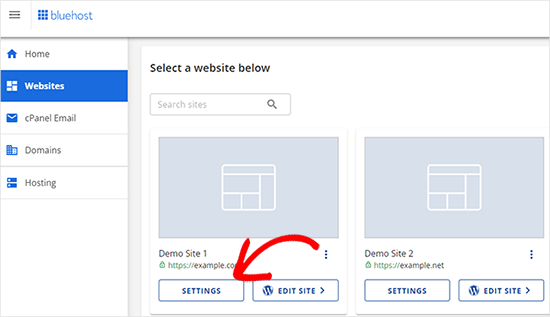
Bir sonraki ekranda, 'Hızlı Bağlantılar' bölümüne doğru aşağı kaydırın.
Ardından, ‘Dosya Yöneticisi’ne tıklayın. Bluehost ayrıca ihtiyacınız olması durumunda WordPress kök klasörünüzü de gösterir.
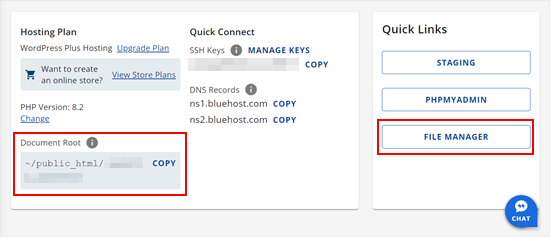
Artık kendi web sitenizin dosya yöneticisinin içinde olmalısınız.
Şimdi wp-content klasörünüzü açın. Ardından, üstteki '+ Klasör'e tıklayın.
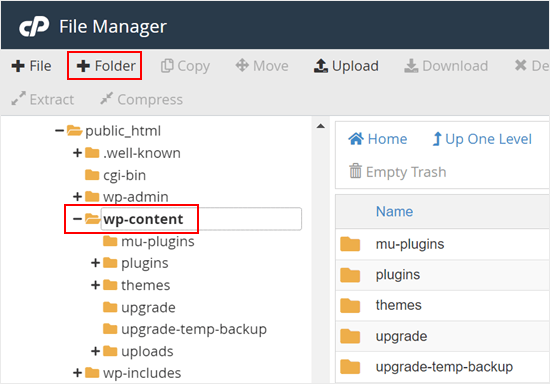
Ardından, yeni klasörünüze bir ad verin. ‘dosyalar’ gibi basit bir şey olabilir. Tam klasör adını not edin, çünkü bir sonraki adımda buna ihtiyacınız olacak.
Bundan sonra, sadece 'Yeni Klasör Oluştur' düğmesine tıklayın.
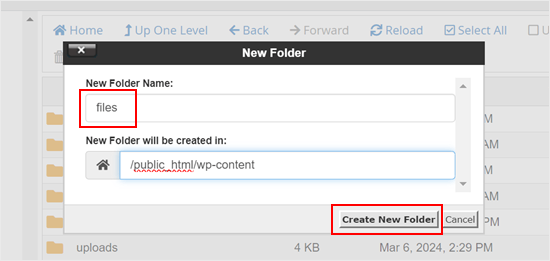
Adım 2: Varsayılan Yükleme Konumunu Değiştirmek İçin Kodu Ekleme
Ardından, WordPress'e varsayılan medya dizinini değiştirmesini söyleyen bir kod parçacığı eklemeniz gerekecek.
💡 Profesyonel İpucu: Bu adıma devam etmeden önce, web sitenizin yedeğini oluşturmanızı öneririz. Bu, herhangi bir hata oluşması durumunda verilerinizin güvende olmasını sağlar.
Bu eğitim için, özel kodu temanızın functions.php dosyasına eklemeniz gerekecek.
En büyük sorun, özel kod parçasındaki küçük bir hata bile WordPress sitenizi bozabilir veya erişilemez hale getirebilir. Ayrıca, bir sonraki WordPress temanızı güncellediğinizde tüm özel kodları kaybedersiniz.
Bu nedenle, WPCode kullanmanızı öneririz. WPCode, WordPress sitenizi riske atmadan özel CSS, PHP, HTML ve daha fazlasını eklemenizi sağlayan en popüler kod parçacığı eklentisidir.
Eklentinin neler yapabileceği hakkında bu detaylı WPCode incelemesinde daha fazla bilgi edinin.
Yapmanız gereken ilk şey, web sitenizde ücretsiz WPCode eklentisini yüklemek ve etkinleştirmektir. Daha fazla ayrıntı için, bir WordPress eklentisinin nasıl kurulacağına dair adım adım kılavuzumuza bakın.
Etkinleştirdikten sonra, WordPress kontrol panelinizde Kod Parçacıkları » Parçacık Ekle bölümüne gidin.
Bu ekranda, farenizi ‘Özel Kodunuzu Ekleyin (Yeni Kod Parçacığı)’ üzerine getirin ve göründüğünde ‘Kod Parçacığını Kullan’ seçeneğine tıklayın.
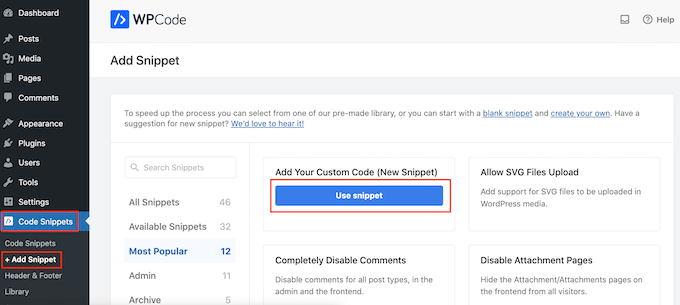
Başlamak için kod parçacığına bir başlık girin. Bu yalnızca referans amaçlıdır, bu yüzden istediğiniz herhangi bir şeyi kullanabilirsiniz.
Bu işlem tamamlandıktan sonra, ‘Kod Türü’ açılır menüsünü açın ve kod türünüz olarak ‘PHP Parçacığı’nı seçin.
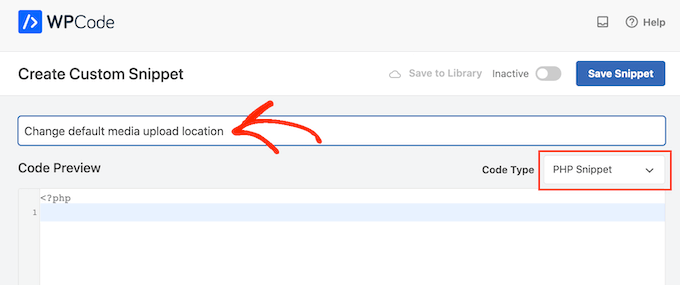
You can now paste the following into the code editor:
define( 'UPLOADS', 'wp-content/'.'files' );
Yukarıdaki kod parçacığı, yükleme dizinini önceki örneğimizdeki gibi wp-content/files olarak değiştirir. Kullanmak istediğiniz konumla değiştirdiğinizden emin olun.
Bundan sonra, ‘Ekleme’ kutusuna gidin ve henüz seçili değilse ‘Otomatik Ekle’yi seçin. Ardından ‘Konum’ açılır menüsünü açabilir ve kod parçasının tüm WordPress web sitenizde aktif olduğundan emin olmak için ‘Her Yerde Çalıştır’ı seçebilirsiniz.
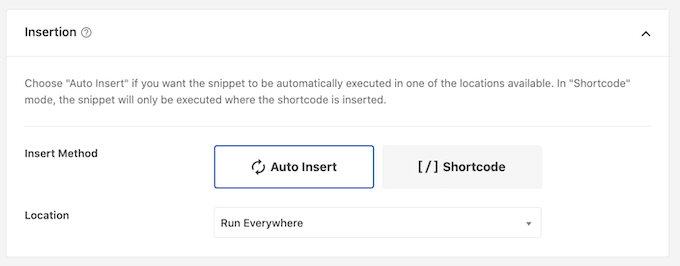
Bu işlem bittikten sonra, ekranın üst kısmına kaydırın ve ‘Etkin Değil’ geçişini tıklayarak ‘Etkin’ olarak görünmesini sağlayın.
Ardından kodu canlı hale getirmek için 'Snippet Kaydet'e tıklayabilirsiniz.
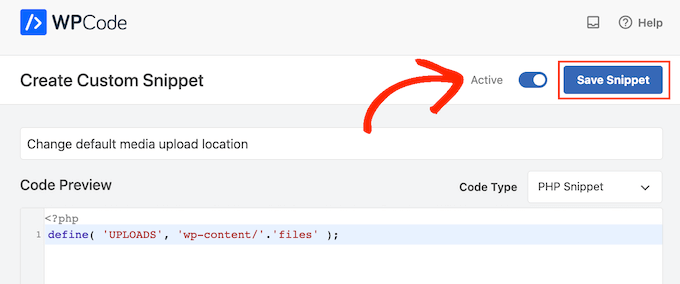
Adım 3: Medya Yükleme Ayarlarınızı Değiştirin (İsteğe Bağlı)
Medya yükleme konumunu değiştirdiğinize göre, dosyaların bu yeni klasör içinde nasıl organize edildiğini değiştirmek isteyebilirsiniz.
Varsayılan olarak WordPress, tüm medya dosyalarını ay ve yıl klasörlerinde saklar. Tüm dosyaları aynı klasöre kaydetmeyi tercih ediyorsanız, Ayarlar » Medya'ya gidin.
Artık 'Yüklemelerimi organize et....' kutusunun işaretini kaldırabilir ve 'Değişiklikleri Kaydet'e tıklayabilirsiniz.
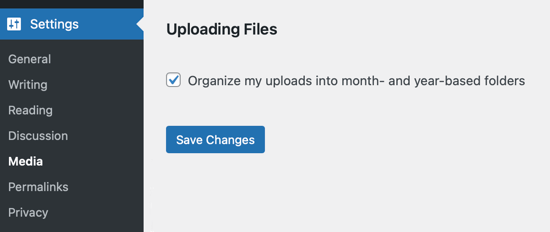
Artık WordPress tüm medya dosyalarınızı aynı klasöre yükleyecektir. Bu dosyaları görmek için FTP istemcisiyle sitenize bağlanın ve seçtiğiniz klasörü açın.
Ek Kaynaklar: WordPress Medyalarını Yönetme
WordPress'te medyayı yönetme şeklinizi kolaylaştırmanın veya iyileştirmenin daha fazla yolunu mu arıyorsunuz? Bu kullanışlı kılavuzlara göz atın:
- WordPress'te Medya Yüklemelerini Kullanıcılara Göre Kolayca Nasıl Düzenlenir
- WordPress'te Resim ve Medya Dosyalarının Adını Yeniden Adlandırma
- WordPress Medya Kitaplığınızı Nasıl Temizlersiniz (Kolay Yollar)
- WordPress Medyasını Boşaltarak Web Sitesi Hızını Nasıl İyileştirirsiniz
- How to Download Your Entire WordPress Media Library
- FTP Kullanarak WordPress Medya Dosyalarını Toplu Olarak Nasıl Yüklenir
Bu makaleyi beğendiyseniz, lütfen WordPress video eğitimleri için YouTube Kanalımıza abone olun. Bizi ayrıca Twitter ve Facebook'ta da bulabilirsiniz.





Manu
Medya dosyalarını medya yükleme konumuna yüklemek gerekli mi yoksa daha mı iyi? Örneğin, varsayılan medya yükleme konumu wp-content/uploads/ ancak ses dosyalarını /files1/ ve /files2 vb. yerlere yerleştirmek istiyorum. Sorun olur mu?
Bu ses dosyaları, kitaplıkta görünmeseler de mükemmel bir şekilde çalmaya devam edecektir (ancak buna ihtiyacım yok). Sesli kitaplardaki QR kodları için sadece kısa URL'ye ihtiyacım var. Teşekkürler.
WPBeginner Desteği
Medya dosyalarınızı nereye ayarlayacağınız kişisel tercihinize bağlıdır, özellikle daha iyi bir konum yoktur ve medya konumunu değiştirmek sorun değildir.
Yönetici
Arif Wali
Hello There,
I have don’t it successfully. When I upload files the systems show the error “The uploaded file could not be moved to files”. Would you please assist me on this?
WPBeginner Desteği
En olası neden, dosya izinlerinizin klasör için doğru şekilde ayarlanmamış olmasıdır. Klasör izinlerinizi ayarlama hakkında daha fazla bilgi için aşağıdaki makalemize bakmak isteyeceksiniz:
https://www.wpbeginner.com/beginners-guide/how-to-fix-file-and-folder-permissions-error-in-wordpress/
Yönetici
arif wali
Çok teşekkür ederim
S.s. Brar
Her şeyden önce size teşekkürler. Bir sorum var. Varsayılan yükleme dizinini değiştirdiğimde, varsayılan Yüklemeler dizinine zaten yüklenmiş olan medya/dosyalar ne olur?
Daha açık olmak gerekirse, zaten çalışan sitemde herhangi bir şeyi bozar mı?
WPBeginner Desteği
Unless you move the old media to the new folder your old media will show broken links
Yönetici
a
Merhaba
Ondan sonra eklentiyi kaldırabilir miyim?
WPBeginner Desteği
Merhaba,
Hangi eklentiyi kaldırmak istiyorsunuz?
Yönetici
sil
Lütfen aşağıdaki hatayı alıyorum, bu da sayfamda veya gönderimde resim yüklememe izin vermiyor
YÜKLEME
Hataları Kapat
12742841_1155189411165548_8438395707068412258_n.jpg
Yükleme sırasında bir hata oluştu. Lütfen daha sonra tekrar deneyin.
WPBeginner Desteği
WordPress'te resim yükleme sorununu nasıl düzelteceğinizle ilgili kılavuzumuza bakabilirsiniz.
Yönetici
muhammed
varsayılan yükleme klasörünü başka bir barındırma hizmetine taşımak istiyorum.
Bazı eklentiler buldum ancak bunlar "varsayılan klasörü !" değiştirmiyor.
Web sitem, resimleri otomatik olarak varsayılan klasöre yükleyen otomatik bir eklenti ile çalışıyor. Varsayılan klasörü web barındırmamda değiştirebilirim ancak başka bir sunucuya değil!
Ne yapmalıyım? Lütfen yardım edin.
dan
harikasın.
Ben
Bu yöntem, yükleme klasörünü harici bir konuma değiştirdiğinizde de çalışır mı?
Fauzi
thanks for sharing,,,
very helpfully
Rio Bermano
Merhaba, bu eğitim için teşekkürler.
Ama bir sorum var.
WordPress güncellendiğinde varsayılana (wp-content/upload) geri dönecek mi?
Cheers
Héctor Cabrera
Selam millet! Makalede, "define" kodunun "That’s all, stop editing! Happy blogging." satırından _önce_ bir yere yerleştirilmesi gerektiğini belirtmelisiniz. Aksi takdirde bazı kullanıcılar için sorun yaratacaktır (daha fazla ayrıntı için bkz.).
Joe
Teşekkürler! Gerçekten bana yaklaşık 10 saatlik bir işten kurtardın!
H. T. Major
Verdiğiniz ipuçları çok faydalı… bunun gibi! Lütfen, iki dizini nasıl “geri alırsınız”? Örneğin, http://example.com/wp/wp-content/files’ım varsa ama http://example.com/files’ı istiyorum, ( ‘UPLOADS’, ”.’files’ ) beni oraya götürmüyor. Beni http://example.com/wp/files’a götürüyor.
Burada bana verebileceğiniz herhangi bir yönlendirme için çok teşekkür ederim!
Miles
H.T. Major ve aşağıdaki gibi bir WordPress yapısına sahip olan herkes:
WEB KÖK DİZİNİ
– wp-content
— uploads
– wordpress_install_files
define(‘UPLOADS’,’wp-content/uploads/’); kullanmak işe yaramaz çünkü göreceli konum olarak wordpress kökünü kullanıyor. Gerçekten herhangi bir mutlak yolu vb. kabul etmiyor gibi görünüyor, sadece wordpress köküne ekliyor.
Ancak şunu kullanırsanız:
define(‘UPLOADS’,’..wp-content/uploads/’); bu sizin istediğiniz şekilde çalışmalıdır. Bununla bir süre uğraştım ve bu işe yarıyor gibi görünüyor.
Miles
Düzenle, düzgün olması için sondaki eğik çizgiyi kaldırın: define(‘UPLOADS’,’..wp-content/uploads’);
Bu, wordpress klasörünüzün dışına, muhtemelen web kök dizinine ve ardından wp-content/uploads klasörüne iki adım geri gidecektir.
Peter
Yüklemeyi bu şekilde değiştirmek istersem ne olur
Eski: /home/public_html/wp-content/uploads
yeni: /home/new folder/uploads
Nico
4.0'da medya kitaplığı klasörü nasıl değiştirilir?
WPBeginner Ekibi
Lütfen bu kılavuza göz atın:
Soliloquy ile Duyarlı Bir WordPress Kaydırıcısını Kolayca Oluşturma
WPBeginner Ekibi
Evet, mümkün. En iyi yol bir CDN Hizmeti kullanmaktır. Bu, daha iyi yedeklilik sağlar ve web sitenizi daha hızlı hale getirir.
Ancak yalnızca medya yükleme dizinini değiştirmek istiyorsanız ve hız sizin için önemli değilse, wp-ftp-media-library'ye bakmalısınız.
Sandeep
Teşekkürler. CDN hakkında biraz araştırma yaptım ama sadece resimleri kullanıcıya en yakın uzak konumdan sunmak için önbelleğe aldığını buldum. Ben sadece farklı bir sunucuya yüklemek istiyorum, bu nedenle ikinci seçenek benim için işe yarayabilir.
Ancak FTP'nin gerçekten güvenli olmayabileceğini düşündüğüm için, aynı şeyi yapmak için HTTP/HTTPS veya Rsync gibi başka bir protokolü nasıl kullanabileceğime dair bir çözümünüz var mı (bunun WP tarafından desteklenip desteklenmediğini merak ediyorum).
Sandeep
Yükleme konumunu başka bir uzak sunucuya tanımlamak mümkün mü?
Somesh
Farklı bir alt alan adı kullanmak istiyorum, bunu nasıl taşıyabilirim ve yolu o alt alan adı adresine nasıl değiştirebilirim?
HasaN
Yükleme yolumu değiştirdim
ancak eski öne çıkan görselim ve medya bağlantılarım artık yeni yola değişti ve bozuk!
Sadece yeni yüklenen medyanın bağlantılarının ve yolunun yeni yola değişmesini istiyorum
ali es
hi . how change address upload media to server.I do not speak English and I have translated the text with Google Translate., Please guide me
Thanks
Jovin
Yüklemeler dizinini değiştirirsem .önceki tüm yüklemelerimi yeni dizine taşımalı mıyım?
WPBeginner Desteği
Öncelikle, varsayılan medya yükleme konumunu WordPress'te değiştirmeden önce mevcut yükleme dizininizi yedeklediğinizden emin olun. Eski yüklemeler dizininizi olduğu gibi bırakabilirsiniz, böylece sitenizdeki eski medyalar bozulmaz. Ancak, eski medya yüklemeleri dizinini hiç kullanmak istemiyorsanız, gönderilerinizdeki, sayfalarınızdaki, widget'larınızdaki medya konumlarının sabit kodlanmış URL'ler olduğunu bilmelisiniz, bu nedenle kendiliğinden değişmezler. Harici resimleri içe aktarmayı deneyebilir ve sitenizdeki tüm resimlerin doğru göründüğünden emin olmak için bozuk bağlantıları kontrol edebilirsiniz.
Yönetici
Jovin
Thanks for the reply
Arvind Bhardwaj
Teşekkürler,
WP 3.5.1'de mükemmel çalıştı
Travis
Yorum için özür dilerim, biraz geç oldu. Bu, daha yeni wp kurulumları (3.6.1) için bunu ele alan bulabildiğim tek makale. Diğerlerinin hepsi misc klasörüyle ilgili. Her neyse, adımları izledim ve çalışıyor, ancak resimler bozuk. Sadece birkaç resimle çalışıyorum, bu yüzden onları yeniden yüklemek büyük bir sorun değil.
Sanırım yeni bir klasör "media" (benim yolum) oluşturmam gerekiyor. Bu, uploads'un altına mı gidecek yoksa uploads'un yerini mi alacak? Aradığım URL şudur: http://mydomain/media/image.png. Çözemedim.
Herhangi bir yardım çok takdir edilecektir
WPBeginner Desteği
yükleme yolunu wp-config.php dosyasına şu şekilde tanımlamanız gerekir:
define( 'UPLOADS', ''.'media' );Yönetici
K.Adam White
Diğer birçok yorumcu gibi, medya yüklemelerimi WordPress kurulumumla aynı dizinde saklamanın bir yolunu istiyordum, örneğin WordPress'i “mydomain.com/wp/” içinde ve medyayı “mydomain.com/uploads/” içinde bulundurmak gibi. Bunu WordPress 3.5'te temamın functions.php dosyasına (veya bir eklentiye) aşağıdakileri ekleyerek benim için çalıştırdım:
if ( empty( $upload_path ) || ‘wp-content/uploads’ == $upload_path ) { update_option( ‘upload_path’, untrailingslashit( str_replace( ‘backend’, ‘files’, ABSPATH ) ) ); update_option( ‘upload_url_path’, home_url( ‘/files’ ) ); }
Umarım bu, WordPress'in gelecekteki bir sürümünde daha kolay hale gelir!
K.Adam White
Güncelleme: Yukarıdaki örnekte, “backend” yerine “wp” (veya WordPress'inizin kurulu olduğu yer) ile değiştirin
David Paul
Bu, sadece bakıldığında işe yarıyor gibi görünse de, neden sadece wp-config dosyanıza 1 satır eklemiyorsunuz? Bu gönderinin sunduğu aynı sonuç için çok fazla ekstra iş gibi görünüyor…
define(‘UPLOADS’,’directory’); eklemek çok daha kolay.
Yury Tilis
Çünkü wp-includes/functions.php'de aşağıdaki 2 senaryoya sahipsiniz:
Belirli bir yükleme dizini belirtilmemişse:
$dir = WP_CONTENT_DIR . ‘/uploads’;
EĞER UPLOADS tanımlıysa:
$dir = ABSPATH . UPLOADS;
Buradaki sorun, ki bu bariz olmalı, ABSPATH her zaman != WP_CONTENT_DIR olmasıdır. WordPress'i bir dizine kurup WP_SITEURL ile işaretlediyseniz, ancak wp-content için farklı bir dizin olarak WP_CONTENT_DIR'yi belirttiyseniz, UPLOADS anlamsız hale gelir ve yukarıdaki hack veya benzeri bir hack olmadan basit bir klasör yeniden adlandırması imkansız hale gelir.
Derek Lapp burada iyi açıklıyor:
nate
Bunu tamamen yanlış yapıyorum olabilir ama müşterilerimin sitelerini geliştirmek için çoklu site kurulumu kullanıyorum… wp-backend'deki kod düzenleyiciyi kullandığım için, css için resimleri yüklemek üzere resim yükleyiciyi de kullanmayı seviyorum…
Which i have created an awesome starter theme which i use widget content sidebar and uploaded images for certain areas like logo spot and even for background images – a “lazy” way of getting images to server..
Site/temayı taşırsam veya alan adlarını değiştirirsem CSS'imde göreceli yollar kullanmak istedim ve normal wp-content/blog23/files yolunu kullanmak istemedim, bu varsayılan resim yükleyici yoludur...
1 için bu, temamın dışında yaşıyor ve css'imde wp-image yükleyici aracılığıyla yüklediğim resimlerle background: url ('images/filename.png') kullanmak istiyorum, böylece temam bağlantılarımı/resimlerimi taşıdığında bozulmaz ve sonra "site canlı yayına gitmeye hazır olduğunda" yükleme yolunu wp-content/blog23/files olarak değiştirmeyi planlıyorum.
Sadece bunun hayatımı kolaylaştıracağını düşünüyorum ve tabii ki muhtemelen bir şeyi gözden kaçırıyorum veya tembelim ama söz veriyorum değilim - buna yeniyim... : )
Site ayarlarındaki yükleme yolunu değiştirdim ama hiçbir şey değişmedi mi? hala blogların dosya yoluna mı yüklüyor?
Nico
Bunu (bu iş parçacığının başka bir yerinden kopyalandığı gibi) çalıştıramıyorum:
define(‘UPLOADS’, ‘files’);
wp-config.php dosyamda.
Resimlerimin example.com/img adresinde olmasını istiyorum
Herhangi bir yardım takdir edilecektir.
Why oh why do they even bother to change things like this. It was SUCH a useful feature.
Nico
Sorunu çözdü. Kodu bu sayfadan kopyaladığımda, tırnak işaretleri "süslü" çeşitti. Onları düz hale getirdiğimde kod çalıştı.
Bunun için teşekkürler.
Nico
Bu, yazılım geliştiricilerin kullanıcılarıyla bağlarını kopardıkça yaptıkları türden bir değişiklik.
Bu seçeneğin kaldırılmasıyla ilgili okuduğum açıklama, çok az kişinin bunu kullandığı ve kullanıcı arayüzünü daha temiz hale getirdiği yönünde. Ne saçmalık.
Josef
Dosyalarımın yolu example.com/files olsun istiyorum
Sadece arka ucu daha cilalı hale getirmek ve WordPress kullandığım gerçeğini gizlemek için.
Sorunum şu, gelecekte bu yöntemi uygularsam herhangi bir sorunla karşılaşır mıyım? Sonraki WordPress güncellemeleri veya siteyi başka bir barındırma hizmetine taşımak… vb?
Tehlikeli mi?
Yayın Kadrosu
Çekirdekte yapıldığı gibi yapmaktan farklı şeyler yapmaya ne zaman karar verirseniz, gelecekteki uyumluluğun sorumluluğunu ve risklerini üstlenirsiniz.
Yönetici
Josef
%100 anlıyorum.
But I want answer for my question, I will be thankful.
Yayın Kadrosu
Your question was will you face any issues, and our response was answering that. We don’t know because so many things can change, but if you do face any issues, then you are responsible for that.
Dan A.
@Josef
Güncellemeler bu yöntemi kullanan sitelerimi hiç etkilemedi. Barındırma hizmeti değiştirirseniz, yapılandırma dosyanızda belirttiğiniz dizinin, gerçek dosyaları tutan dizinle tutarlı olduğundan emin olun, o zaman herhangi bir sorun yaşamazsınız.
Bir keresinde barındırıcı değiştirdim ve yükleme dizinimin adını değiştirmeye karar verdim… Görüntüleri yeni dizine taşıdıktan sonra eski dizin adına sahip tüm görüntülere ve dosyalara bozuk bağlantılarım oldu. Bozuk bağlantıların yollarını güncellemek için veritabanına girmek acı vericiydi.
Tutarlı kalın.
James
Merhaba,
Soru, kullanıcı başına yükleme dizinini nasıl özelleştirebilirim?
Bu gereksinimler için mevcut bir eklenti var mı?
Teşekkürler!
Papa Smurf
Pro tip: you don’t need to prepend empty strings to strings.
define(‘UPLOADS’, ”.’files’);
şöyle olmalı:
define(‘UPLOADS’, ‘files’);
Wordpress kaynak kodu zaten yeterince kötü durumda…
Facu
Thanks a lot! This was very helpful for me
Connie
3.5.1 sürümüne yükselttikten sonra medya yükleyicinin hiç çalışmadığını fark ettim. (Hala çalışmıyor)
ayrıca bazı eklentiler sabitler veya ayarlar yerine geleneksel "wp-content/uploads" kullanıyor gibi görünüyor…
bu gerçekten bir sorun, medya yükleyiciyi kullanamıyorum....
Connie
Sabiti wp-config'e ekledim. Medya yükleme, tanımlanan klasöre yükleniyor, ancak bir gönderiyi düzenlerken medya yükleyici hiç çalışmıyor, boş, tıklayınca tepki vermiyor...
Ne cüret ama…
Matteo
belki sunucunuz windows, linux daha iyi
Yayın Kadrosu
Bunu yaptığınızda her zaman eklentilerle sorun yaşarsınız. Bu seçenek ortalama kullanıcılar tarafından kullanılmak üzere tasarlanmamıştır. Kullanırken, bunu yapmanız için yeterince iyi bir nedeniniz olmalı.
Yönetici
Mattia Frigeri
Yükleme klasörünün uygun olduğunu ama en iyi organizasyonun yıllar veya aylar değil, dosyanın bulunduğu gönderi/sayfanın bölümü olması gerektiğini düşünen tek kişi ben miyim? Başlığı değil, bölümü! Bu belki de tek bir resmin 2 gönderide/sayfada kullanılmasıyla sorun yaratabilir. Ama bir resmi asla iki farklı yerde kullanmam...
RVOLA
Merhaba, Wordpress 3.5'in yeni özellikleri için küçük bir eklenti yazdım.
Alan adını veya alt alan adını doğrudan değiştirebilirsiniz
http://wordpress.org/extend/plugins/wp-original-media-path/
FragaGeddon
Teşekkürler, bu iyi çalışıyor!
Chaitanya
Lütfen Yardım Edin…
Varsayılan yükleme klasörüyle ilgili bir sorunum yok, ancak izinlerini 777 olarak ayarlamadan bu klasöre herhangi bir dosya yükleyemiyorum. Ancak bunun tehlikeli olabileceğini düşünüyorum. Bunun bir yolu var mı?
Yayın Kadrosu
Sunucu yöneticinizle konuşun.
Yönetici
fred
lol güzel, MS teknik desteği gibi konuşuyorsun, soruna cevap olarak yöneticiye kendi yöneticisiyle konuşmasını söylüyorsun
Yayın Kadrosu
Kullanıcı 777 izinlerini değiştirmekten korkuyor. Sunucuları üzerinde hiçbir kontrolümüz yok ve kullanıcının da olup olmadığını bilmiyoruz. Bu yüzden tam olarak nasıl yardımcı olmamızı istediğinizi emin değilim.
Samarn
Başka bir deyişle, yükleme dizini yolunu değiştirmek için bu url'yi /wp-admin/options.php kullanabilirsiniz. Ardından, yükleme dizininizin yolunu girmek için upload_path'i bulun. Varsayılan olarak wp-content/uploads'tur. Dizin dosyaları için wp-content/files olarak değiştirebilirsiniz. Veya wp-content ile aynı seviyedeki dizin dosyaları için files olarak değiştirebilirsiniz.
Medyayı alt alan adına kaydetmek istiyorsanız. Alt alan adınızın url'sini upload_url_path'e girmeniz ve ardından alt alan adınızı yukarıdaki yükleme dizininin yoluna yönlendirmeniz gerekir.
Bunu değiştirdikten sonra. Eski dizin adını yeni dizin adıyla yeniden adlandırmalı veya eski dizindeki tüm dosya ve dizinleri yeni dizine taşımalısınız. Bunu yapmazsanız. Dosyalar bulunamaz.
umarım bu faydalı olur ve ingilizcem için özür dilerim.
Chris
Teşekkürler, bu çok çok yardımcı oldu.
Dave
Bunu *YAPABİLİRSİNİZ*, işe yarayacaktır, ancak temel bir dosyayı değiştiriyorsunuz. Bu, WP güncellendiğinde büyük bir sorun potansiyeli taşır. Güncelleme sırasında DOKUNULMAYAN buradaki önerildiği gibi wp-config dosyasını değiştirmek daha iyidir.
A.K.
Aptalca değişiklik! Klasörü /images/ gibi bir şeye bile değiştirdim…
John
Burada bir şey bulduğumu sanıyordum. 12 siteye sahip bir WP kurulumum var. Tamamen yeni. Sitelerden biri mükemmel durumda ancak diğerlerinde yüklenen resimlerin/belgelerin görünmesini sağlayamıyoruz. Var olmayan bir klasörde referans veriliyorlar. Tüm bunları buraya yazmak yerine WordPress'teki konuyu şu adresten okuyabilirsiniz: http://wordpress.org/support/topic/pictures-do-not-display-3?replies=5. Konu soğudu ama yardıma çok ihtiyacım var ve herhangi bir yardım takdir edilecektir.
Henry
Yukarıdakiyle aynı, 3.5'i birkaç yeni siteye yüklemeyi denedim ve ne yaparsam yapayım bir alt alan adına değiştiremiyorum. Medya yüklemesini bir alt alan adına nasıl değiştireceğimi bilen var mı?
Ed
Paylaştığınız için teşekkürler. Ancak bir şeyleri kaçırıyor gibiyim çünkü örneğinizi kök dizine resim eklemek için kullanmak istiyorum, örneğin: “http://mydomain/images”
Ve örneğinize dayanarak yaptığım şey, bunu şu şekilde girmektir:
define ( ‘UPLOADS’, ‘http://mydomain/images’ ‘.’files’ );
sorun şu ki, medyalarım şimdi adresi "http://otherdomain/http://mydomain/images" olarak gösteriyor, yani medya hala mevcut alanında kalıyor ve bir kök dizine dışarı taşınmıyor.
Umarım anlaşılır olmuştur. Herhangi bir tavsiyeniz var mı?
Jaybe
Yaptığınız şey, sağlanan örnekle tutarlı değil. Sağlanan örnek yalnızca dizin konumunu/yolunu ayarlar, URI'yi değil.
Yüklemeler dizinini/konumunu yapılandırırken şemayı (http://) dahil ediyorsunuz, bu uygun değil ve dahası, işleri bozuyor.
Muhtemelen yüklemeler için URI'yi de tanımlamak istiyorsunuz.
Yorumlardaki diğer kişiler de aynı şeyi soruyor gibi görünüyor.
— Örneğin Yüklemeleri ve medya yüklemelerini bir alt alan adından nasıl yaparım?
Yüklemeler/medya için iki konum belirtildiğine dikkat edin:
1. Yüklemeler dizini/konumu.
2. URI.
Yüklemeler dizini/konumu aşağıdaki gibi bir sabit olarak belirtilebilir:
define( ‘UPLOADS’, ”.’files’ );
Bu, varsayılan alan adı üzerinden aşağıdaki gibi dosyaların yüklenmesini ve başvurulmasını sağlayacaktır:
(örnek) http://domain.tld/files
Bu yalnızca dizin yolunu/konumunu ayarlar, alt/alan adını AYARLAMAZ.
2. URI
URI, yüklemelere ulaşmak/erişmek için tam URL/yoldur ve UPLOADS sabitinin önüne eklenir (yukarıdaki #1).
Ne yazık ki ve garip bir şekilde, bu bir sabit olarak tanımlanamaz. Ancak, filtre (wp_upload_dir) aracılığıyla veya veritabanı tablosu girdisini doğrudan düzenleyerek ayarlanabilir.
Veritabanı tablo girişi konumu aşağıdaki gibidir:
Veritabanı/ wp_options/ upload_url_path
* Not: Veritabanındaki upload_path ve/veya upload_path_url'yi düzenleyerek, WordPress Yönetici/ Ortam/ Dosya Yükleme bölümü aracılığıyla bu alanları yönetmek için ön uç kullanıcı arayüzünü daha önce olduğu gibi yeniden etkinleştireceksiniz.
Ortamı alt/başka bir alan adı üzerinden barındırmak isteyenler için, upload_url_path'i aşağıdaki gibi değiştirebilirsiniz:
database/ wp_options/ upload_url_path:
(example) http://mycdn.mydomain.tld
Elbette, alt/alan adını ilgili konuma/dizine doğru şekilde yönlendirmek için web sunucunuzu (veya sunucularınızı) yapılandırmanız gerekecektir.
Umarım yardımcı olur.
Julie Olson-Rachlin
Jaybe — TEŞEKKÜRLER.
I never had any issues with this – until today.
Barış!
Hamza
and what if I want to put media in a subdomain ?
evan
Aynı sorum var
Eddy
Teşekkürler. Eğitiminiz çok yardımcı oldu.
chrismccoy
great post, the define isnt heavily documented, so its great someone is posting about it, i had a few clients who had their uploads in /pics and /images so this wasnt doable via 3.5 without the define for new installs.
Rhea
Hi. Thanks for this. But I need the images saved outside of my wordpress site..
örn:
public_html/site /// bu benim wordpress sitem
public_html/media /// tüm resimleri bunun yerine kaydetmek istediğim yer.
TIA
Pietro Gregorini
Aynı şeyi bilmek isterim, yükleme klasörünü wordpress kök dizininin DIŞINA koymak mümkün mü?
Sam Ward
Yukarıda bahsedilen upload_url_path'i değiştirmeniz gerekiyor ancak bu, wordpress'in çekirdek dosyalarından birini değiştirmeyi içeriyor.
Birkaç gönderi yukarıda yayınlanan güzel bir eklenti var, hepsi sizin için halledecektir.
You can uninstall the plugin once you have made your changes to.
Saurabh
and what if I want to put media in a subdomain ?
Carlos Varela
Yapılandırmanızda bir medya barındırıcısı tanımlayabilirsiniz
define (‘MEDIA_HOST’, ‘http://media.yourdomain.com’);
Maarten
Bu değişiklikten pek memnun değilim çünkü WordPress yüklenen medyayı sunmak için bir alt alan adı kullanıyor. Bu, yükseltmeden sonra hala çalışıyor, ancak yeni bloglarda artık mevcut değil..
Yükleme dizini ve indirme yolu için iki alan olmadan, onları yalnızca WP ile aynı alan adından sunabilirim, istediğim çerezsiz bir alan adından değil.
Jaybe
Yolu ve URI'yi ilgili veritabanı girişleri aracılığıyla ayarlamak hala mümkündür.
Bir sabit tanımlamak kadar zarif değil ama yine de çoğu kişi için bu tür ayarlar üzerinde değişiklik yapmayı düşünenler için aynı derecede kolay ve erişilebilir.
Sheik Yerbouti
Sitem tamamen https. Kullanmaya çalıştığım her slayt gösterisi eklentisi, görüntülenecek resim için sağlanan URL'yi ekler. Sorun, slayt gösterisi kullanan herhangi bir sayfanın güvenli olmayan içerik olarak bildirilmesidir. Slayt gösterisindeki (veya slayt gösterilerindeki) veya Medya sayfalarındaki URL'yi düzenlemenin bir yolu yok gibi görünüyor. Slayt gösterilerini güvenli hale getirmek için bir URL'yi nasıl düzenlerim?
Sheik Yerbouti
WP Original Media Path'i deneyin. Bu eklenti, yolu ve mevcut tüm dosya yollarını tek seferde değiştirecektir.